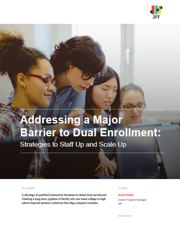Addressing a Major Barrier to Dual Enrollment: Strategies to Staff Up and Scale Up
March 29, 2019
By Sarah Hooker, Jobs for the Future
An acute shortage of qualified instructors threatens to derail dual enrollment, an effective and popular college transition strategy, just as the movement is picking up steam. Financial incentives have helped some school districts increase the number of high school teachers who are credentialed to teach college-level courses to their students. But, to date, such efforts have led only to incremental progress.
In order to fulfill the potential of dual enrollment to improve high school completion, postsecondary success, and career readiness—particularly for underserved young people—it is essential to develop systemic solutions to the staffing crisis. Only through new approaches that merge the K-12, undergraduate, and graduate education systems can we address the host of logistical, political, and cultural challenges that have long stymied individual districts and colleges.
This brief is intended for policymakers, education system leaders, and dual enrollment advocates who are considering what it will take to build long-term strategies that significantly expand the supply of instructors qualified to teach college in high school. Our recommendations are rooted in JFF’s recent partnership with two very different sites—Denver Public Schools (Colorado) and Mounds View Public Schools (Minnesota)—that shared the aim of increasing this pool of educators (see box on JFF’s work).
READ THE FULL REPORT

This work was made possible with support from ECMC Foundation
